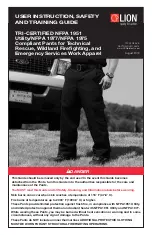
14
WARNING
!
Do not confuse the component testing requirements that are part of NFPA Standards with
the conditions in which Technical Rescue and/or Wildland Firefighting personnel work. For
example, the requirement that certain components must not melt, drip, or separate when
exposed to convected heat temperatures of 500° F for 5 minutes is in no way intended
to indicate that Technical Rescue or Wildland firefighting personnel face that condition in
their work, or could be expected to withstand that condition EVEN WHILE WEARING THE
PANTS CORRECTLY without suffering serious injury or death.
WARNING
!
Overexertion in hot conditions while wearing NFPA 1951 Utility/NFPA 1977/NFPA 1975
Tri-Certified Pants can lead to heat exhaustion, or heat stroke. Symptoms of
heat
exhaustion
are a general feeling of weakness, dizziness, rapid pulse, low blood pressure
while standing or sitting, and/or a headache. The skin may feel moist and clammy. If you feel
symptoms, get to a cool place, remove your Pants, and drink fluids. Failure to seek attention
could lead to severe coma or death.
WARNING
!
Symptoms of
heat stroke
are hot, dry skin with no sweating, very high body
temperatures, weakness, dizziness, rapid breathing, nausea, unconsciousness, and
sometimes mental confusion. If you feel any of the above symptoms at any time, get to a
cool area immediately, remove your Pants, drink fluids and seek medical attention. Failure
to seek attention could lead to coma or death. Immediate cooling is essential for survival
in heat stroke cases.
WARNING
!
You must be physically
fit to safely perform
strenuous work under
stressful conditions.
Regular cardiovascular
exercise, abstaining
from cigarette smoking,
proper training, a
healthy diet, and
avoidance of obesity,
can help to reduce the
risk of heart attack.
10.3
HEAT STRESS: A SIGNIFICANT CAUSE OF
RESPONDER INJURIES
Physical work in a warm or hot environment causes a rise in the temperature
inside the body. To protect the body against heat, the heart begins to beat faster
so that more blood can be moved to the skin surface. Blood vessels near the skin
dilate so that they can carry more blood. In this way, blood in the interior of the
body can be brought out near the body’s surface and cooled. Most importantly,
the body produces sweat that evaporates off the skin to provide cooling. Those
natural responses do not work very well for any or all of the following conditions:
the ambient air temperature is at least 75° F (23.9° C) or higher, the garment’s
insulation blocks the transfer of heat away from the body, the garment blocks the
evaporation of sweat, or the exertion of the muscles produces more heat than
the system can remove. When the body temperature gets elevated too high, the
results can be heat strain, heat exhaustion, or heat stroke.
10.4
HEART ATTACKS: A RESULT OF OVEREXERTION
During Technical Rescue and/or Wildland Firefighting
operations, the heart beats faster because of the need
to move more blood to the working muscles. This
blood carries more oxygen to the muscles so that they
can handle the increased workload.
Another factor in increasing the rate of the heart is the
presence of adrenaline, the “fight or flight” hormone, in
the user’s body during an emergency. The adrenaline
present in your system causes the heart to pump even
faster than during normal activity.
All of these factors could place too much stress on
the heart, leading to a heart attack. The heart simply
cannot handle the load placed on it.
Summary of Contents for NFPA 1975
Page 22: ...22 NOTES...
























